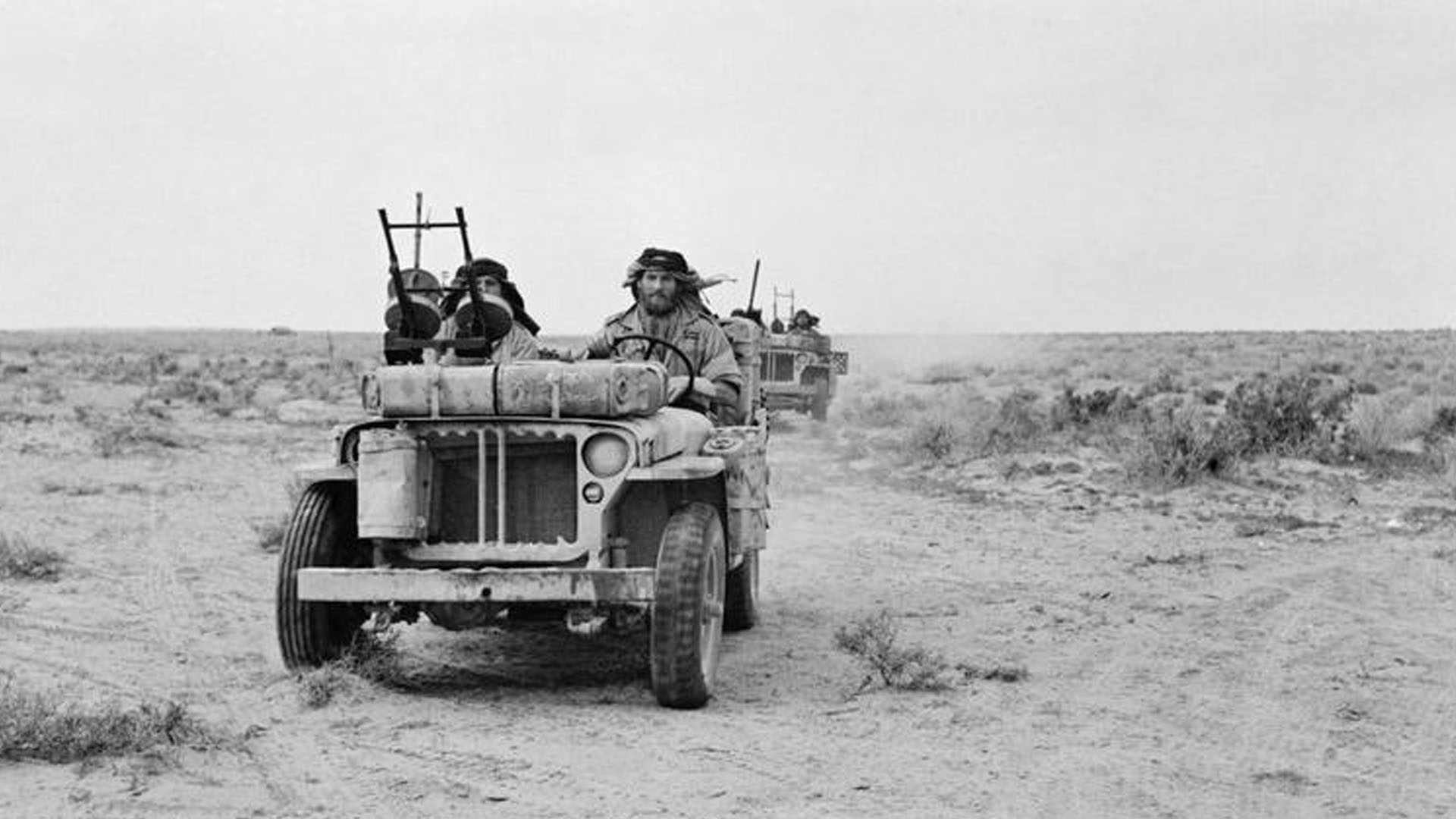Lieutenant Colonel Robert Blair Mayne to some was simply Colonel Paddy. The Northern Irish man was one of the founding members of the Special Air Service or SAS.
The elite commando unit was the brainchild of Scots Guard officer Captain David Stirling. Their aim was to act behind enemy lines and take the fight to Rommel in the desert. Although Mayne was languishing in a prison cell after an altercation with a superior officer, he was just the man for the job.

Imperial War Museum Photo: E 21337 (Part of the War Office Second World War Official Collection). A heavily armed unit of L Detachment SAS in the North African desert on 18th January 1943. Photo taken by Major Geoffrey Keating – No 1 Army Film & Photographic Unit.
Stirling formed the L Detachment Special Air Service of sixty men, including Colonel Paddy. Mayne’s reputation preceded him and his actions on the Litani River had brought him to Stirling’s attention.
Over the course of the war, the legend of Colonel Paddy would grow. Stories of drinking and brawling were commonplace. His fearlessness behind lines, though, earned him a reputation as a heroic warrior.
Tamet Raid 1, 1941
The first raid carried out by L Detachment was a failure. The unit learned from mistakes made and on 8th December 1941, they attacked Tamet and Sirte. Along with seven other men, Paddy Mayne destroyed 25 enemy aircraft on the ground. They also took out fuel and ammunition dumps. For this, he received his first Distinguished Service Order. This action also quieted some in the British Army who wanted to disband the unit.
Mayne’s official report outlined the following damage:
- Bombs were placed on 14 aircraft.
- 10 aircraft were damaged by having instrument panels destroyed.
- Bomb and petrol dumps were blown up.
- Reconnaissance was made down to the seafront but only empty huts were found.
- Several telephone poles were blown up.
- Some Italians were followed, and the hut they came out of was attacked by sub-machine gun and pistol fire and bombs were placed on and around it. There appeared to be roughly thirty inhabitants. Damage inflicted unknown.
Tamet Raid 2, 1941
Mayne returned to Tamet with a smaller unit of only five men on 27th December 1941. On this occasion, a further 27 enemy planes and other vehicles faced destruction. Even when the group ran out of explosives, the damage continued. Reportedly, Mayne ripped electrical equipment from cockpits and dashboards with his bare hands. Following this second action in Tamet, Mayne gained promotion. He was now second in charge of L Detachment SAS with only Stirling above him.

Imperial War Museum Photo: E 21341 (Part of the War Office Second World War Official Collection). A Special Air Service (SAS) patrol in a Jeep in the North African desert. Photo taken by Major Geoffrey Keating – No 1 Army Film & Photographic Unit.
Egypt, 1942
Throughout the desert campaign in North Africa, the SAS became known for their use of armoured Jeeps. Willys Jeeps arrived for their use in early July 1942. Stirling and Mayne fitted theirs with powerful Vickers K machine guns. The first “Jeep raid” took place at Kufra. Again, North African airfields were the prime target. Mayne and his unit destroyed many more planes at El Daba, Fuka and Sidi Haneish. By the end of the war, reports suggested that Mayne was responsible for the destruction of between 100 and 150 aircraft.
Sicily, 1943
On 10th July 1943, Mayne led a group of men to Sicily. They landed at Capo Murro Di Porco and quickly captured two gun positions and hundreds of Italian troops. By the end of the day 450 men had been captured and more than 200 more killed. This action was vital for the safe landing there of 13 Corps. The following day, they landed at Augusta and captured the town in broad daylight. It was Colonel Paddy Mayne himself who led the charge from the landing craft under machine gun fire. This raid saw Mayne receive the 1st bar to his Distinguished Service Order.

Imperial War Museum Photo: NA 676 (Part of the War Office Second World War Official Collection). An SAS Jeep in Gabes-Tozeur, Tunisia in 1943. The gunner has a .50 inch Browning while the driver is armed with a single Vickers ‘K’. Photo taken by Sergeant Currey – No 2 Army Film & Photographic Unit.
Normandy, 1944
At the height of the Battle of Normandy, on 9th August 1944, Mayne parachuted behind enemy lines. In France, he conducted reconnaissance before returning again on 19th August near Orleans. From there he pushed through enemy lines killing many German soldiers with machine guns mounted on Jeeps. This led to the second bar on his DSO. Many such raids were carried out throughout France in 1944.
Oldenburg, 1945
On 10th April 1945, the push towards Berlin was underway. Near the village of Borgerwald, an SAS unit was ambushed and their commanding officer killed. Mayne took over the Jeep, manning the guns and some say he single-handedly rescued every man and forced the Germans to retreat. For this daring feat, he was recommended for the Victoria Cross. The citation was signed off by Field Marshall Montgomery but the award would elude Colonel Paddy. He received a 3rd bar on his DSO and his name would be remembered as the stuff of legends.
Lieutenant Colonel Robert Blair “Paddy” Mayne died in 1955. The cause was a car accident in his hometown of Newtownards in Co. Down. He is buried in the nearby Movilla Abbey Cemetery.